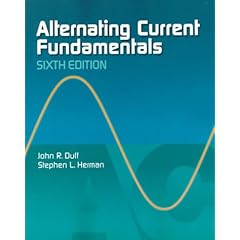AMAZON multi-meters discounts AMAZON oscilloscope discounts
The term "AC drive" is a bit vague. Commonly, it refers to a variable-frequency drive (VFD) -- also known as an inverter -- that's used to adjust the speed (among other parameters) of an AC motor. This is definition used in all topical discussion on this web site.
Variable-Frequency Drives (also known as AC Drives and Inverters)
Variable-frequency drives (VFD) for AC motors have been the innovation that has brought the use of AC motors back into prominence. The AC-induction motor can have its speed changed by changing the frequency of the voltage used to power it. This means that if the voltage applied to an AC motor is 60 Hz (used in countries like US), the motor will run at its rated speed. If the frequency is increased above 60 Hz, the motor will run faster than its rated speed, and if the frequency of the supply voltage is less than 60 Hz, the motor will run slower than its rated speed. The variable-frequency drive is the electronic controller specifically designed to change the frequency of voltage supplied to the motor.
In the 1960s, the frequency drives had rather small solid-state components that limited the amount of current the drive could supply to the motor. This usually limited the size of the motor that could be controlled by a frequency and they were not commonly used. When larger transistors became available in the 1980s, variable-frequency drives allowed the largest motors to have their speed controlled. The earliest drives used linear amplifiers to control all aspects of the drive. Jumpers and dip switches were used provide ramp-up (acceleration) and ramp-down (deceleration) features by switching larger or smaller resistors into circuits with capacitors to create different slopes.
The arrival of advanced microprocessors has allowed the variable-frequency drive to become an extremely versatile device that not only controls the speed of the motor, but protects against overcurrent during ramp-up and ramp-down conditions. Newer drives also provide methods of braking, power boost during ramp-up, and a variety of controls during ramp-down. The biggest savings that the variable-frequency drive provides is that it can ensure that the motor doesn't pull excessive current when it starts, so the overall demand factor for the entire factory can be controlled to keep the utility bill as low as possible. This feature alone can provide payback in excess of the price of the drive in less than one year after purchase. It is important to remember that with a traditional motor starter, they will draw locked-rotor amperage (LRA) when they are starting. When the locked-rotor amperage occurs across many motors in a manufacturing plant, it pushes the electrical demand too high which often results in the plant paying a penalty for all of the electricity consumed during the billing period. Since the penalty may be as much as 15% to 25%, the savings on a $30,000/month electric bill can be used to justify the purchase AC drives for virtually every motor in the plant even if the application may not require variable speed.

Today the variable-frequency drive is perhaps the most common type of output or load for a control system. As applications become more complex the frequency drive has the ability to control the speed of the motor, the direction the motor shaft is turning, the torque the motor provides to a load and any other motor parameter that can be sensed. Newer drives have a variety of parameters that can be controlled by numbers programmed into it or downloaded from another microprocessor-controlled system such as a programmable controller (PLC). These drives are also available in smaller sizes that are cost-efficient and take up less space.
PREVIOUS: DC Drives | NEXT: AC Drives: Block Diagram of a Variable-Frequency Drive
Recommended Books:
 Alternating
Current Fundamentals (Paperback)
Alternating
Current Fundamentals (Paperback)
by John R. Duff, Stephen L. Herman
This comprehensive book on AC theories and applications has been revised and updated to contain the latest in alternating current applications. Features: -additional examples of basic AC circuits have been added to offer more real-world applications to relate theory -expanded review questions monitor progress -organization of book builds knowledge of AC by starting with basic principles and progressing to more difficult concepts. Contains information on single-phase and three-phase transformers. Coverage includes examples of how to calculate values of voltage, current, and turns for different types of transformers. Softcover. DLC: Electric currents, Alternating.
Purchase Alternating Current Fundamentals
 Audel
Electric Motors
Audel
Electric Motors
Topics covered: varying speed characteristic, step servo, motor from the line, reluctance synchronous motor, most small motors, centrifugally operated switch, reel rack, accelerating contactors, shaded pole, unipolar drive, repulsion induction motor, play washers, split phase, repulsion motor, excessive mechanical noise, motor repair work, capacitor start, split capacitor, commutator surface, shaft adapters, cage winding, wound rotor, main winding, high mica, capacitor motors.
Here’s the ultimate motor tool:
If you need information about installing, repairing, and maintaining any
type of electric motor, this book belongs in your toolbox. Completely
revised and illustrated, it covers principles of motor function, choosing and replacing motors, identifying and repairing common problems, performing
routine maintenance, and more, all without excessive math. It’s the guide
your father relied on, now fully updated for the twenty-first century.
Understand both AC and DC motor function and operation:
- Repair small series motors and troubleshoot special types of motors
- Compare methods of motor control, including various switches, starters, and timing relays
- Troubleshoot fractional horsepower motors, including split-phase induction, capacitor start, repulsion, shaded-pole, hysteresis synchronous, and universal motors
- Learn the best procedures for stripping and rewinding armatures and stators
- Modify AC motors for speed control
- Discover which tools and supplies you’ll always need
Pocket guide covers installing, repairing, and maintaining any type of
electric motor. Includes principles of motor function, and more. Softcover.
Purchase
Audel Electric Motors